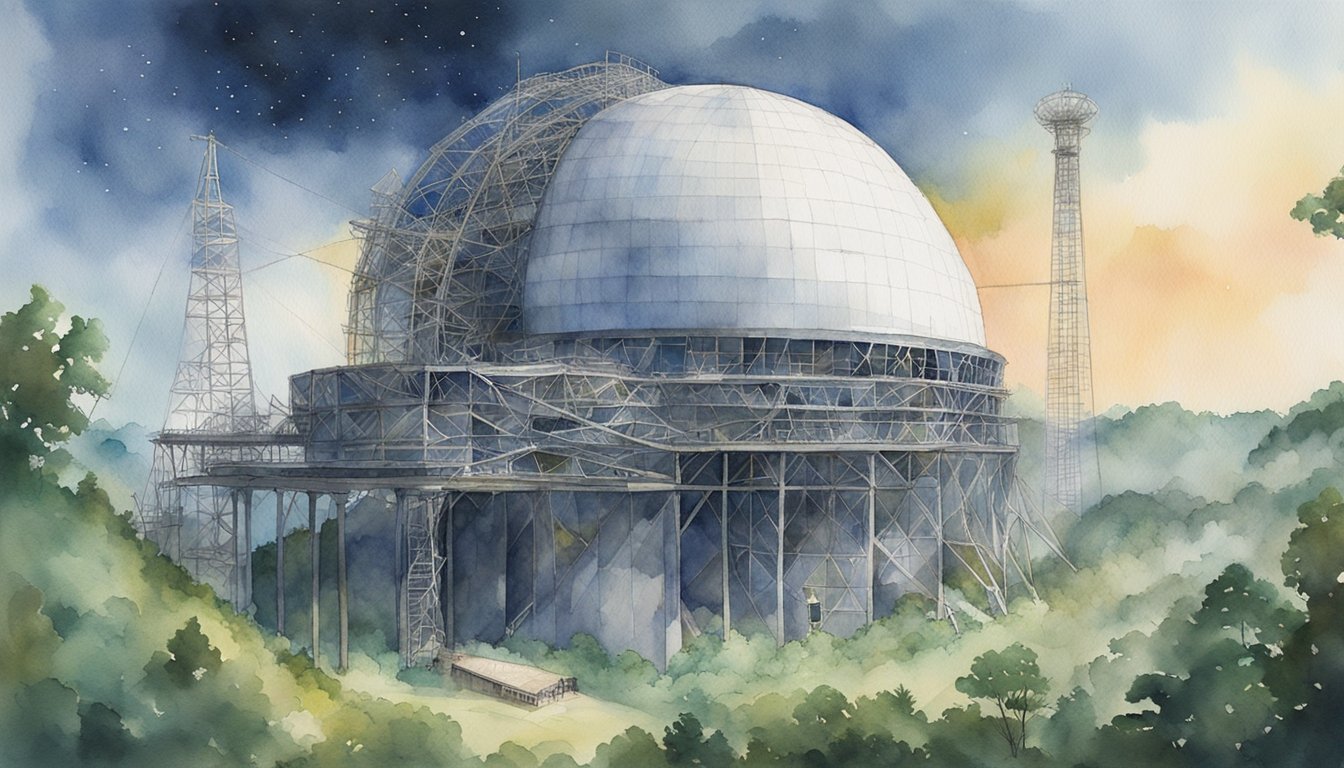History and Significance of Arecibo Observatory

The Arecibo Observatory, nestled in the hills of Puerto Rico, represents a monumental leap in astronomy and planetary studies. From its inception, it has provided invaluable data, fostered scientific advancements, and even stepped into the limelight of popular culture.
Foundation and Mission
Initially conceived by Cornell University and funded by the National Science Foundation, the Arecibo Observatory began its journey in the early 1960s with the primary goal of studying the Earth’s ionosphere. Situated in the lush landscape of Puerto Rico, it was not only chosen for its geographical advantage but also for accommodating a vast dish required for intercepting radio waves from space.
Notable Achievements
Remarkable in its scientific contributions, Arecibo played a vital role in advancing our understanding of radar astronomy. It was pivotal in mapping the surface of Venus, discovering the first binary pulsar, and, more recently, contributed to the study of geophysical radar for planetary observations. In a collaborative environment, Arecibo worked alongside NASA and other institutions, bolstering research that extends from our atmosphere right out to distant galaxies.
James Bond and Pop Culture
Arecibo Observatory transcended science, becoming an icon through its appearances in film and literature. It famously featured in the James Bond film “GoldenEye,” where it was portrayed as a satellite control center—an instant classic moment for movie fans. Moreover, the installation was also spotlighted in the film adaptation of Carl Sagan’s novel Contact, which fictionalized the use of the observatory in the search for extraterrestrial intelligence, both cementing its place in pop culture and sparking public interest in astronomy.
Scientific Contributions and Discoveries
The Arecibo Observatory has been a treasure trove of astronomical insights, with significant advancements in radio astronomy, planetary research, and the ongoing quest for extraterrestrial intelligence.

Pioneering Radio Astronomy
Arecibo’s colossal radio telescope facilitated in-depth studies of pulsars and the ionosphere, contributing vastly to atmospheric science. It has played a crucial role in our understanding of these celestial phenomena, including the groundbreaking discovery of a binary pulsar, which later substantiated the existence of gravitational waves predicted by Einstein’s general relativity.
Asteroids and Planetary Research
Equipped with a powerful radar, Arecibo was instrumental in Asteroids and planetary research, closely observing Near-Earth Objects (NEOs), which helped planetary scientists assess potential earth impact risks. These observations contributed to our knowledge of the composition and structure of various asteroids.
SETI and the Search for Extraterrestrial Intelligence
For years, the Arecibo Observatory has been at the forefront of the Search for Extraterrestrial Intelligence(SETI), utilizing its unrivaled sensitivity to detect faint signals from distant worlds. It has inspected parts of the sky for signals from intelligent life, engaging the scientific community’s curiosity about what exists beyond our own planet.
How Do Avi Loeb’s Unconventional Theories Relate to Discoveries Made at the Arecibo Observatory?
Arecibo Observatory, known for its massive radio telescope, played a pivotal role in advancing our understanding of the universe. Avi loeb’s groundbreaking ideas on cosmic phenomena challenge conventional astrophysics, encouraging scientists to rethink previously dismissed signals, such as mysterious fast radio bursts and interstellar objects. These intersections spark innovative research directions.
Destruction and Future Prospects

The recent collapse of the iconic Arecibo Observatory was a significant loss to the scientific community, but there are ambitious plans for its future that could redefine radio astronomy.
Collapse of the Observatory
In December 2020, the Arecibo Observatory’s fate was sealed when its 900-ton platform suspended above the radio dish fell, inflicting irreparable damage. The downfall was preceded by cable failures, marking the end of an era for this once world-renowned facility. Having weathered the ferocity of Hurricane Maria back in 2017, the observatory struggled with structural stability, raising concerns about the sustainability of its massive structure.
Impact on Research and Community
Arecibo’s collapse sent shockwaves through the scientific community. The loss affected countless projects, from probing the mysteries of the Solar System to scanning the cosmos for signals of extraterrestrial intelligence. Locally, it was a cultural and educational landmark, and internationally, it left a void in core research areas. The University of Central Florida, among other institutions, mourned the loss of a facility that served as a focal point for scientific collaboration.
Rebuilding and Looking Ahead
The future, however, holds promise. There’s talk of constructing the Next Generation Arecibo Telescope, an advanced facility to exceed the capabilities of its predecessor. This new telescope would harness state-of-the-art technology to equip it with even more powerful tools for discovery. Also, in the broader landscape of radio astronomy, China’s FAST (Five-hundred-meter Aperture Spherical Radio Telescope) has taken up the mantle as the largest single-aperture telescope, wrapped in its aluminum panels, and stands ready to advance the frontiers of space exploration. While the Arecibo Observatory’s story was met with an untimely end, these rejuvenating endeavors ensure its legacy will be carried forward into the cosmos.

